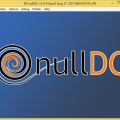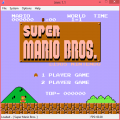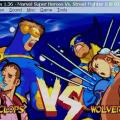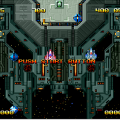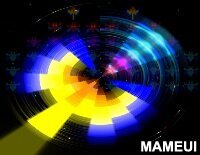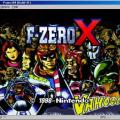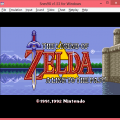- 0 replies
- 1,594 views
- Add Reply
- 0 replies
- 1,825 views
- Add Reply
- 0 replies
- 1,329 views
- Add Reply
- Note: because of TIA/6502 changes, the state file format has changed again, and old state files will not work with this release.
- Several bugfixes and improvements to the debugger:
- Improved display of debugger when using larger video modes. There are now three font sizes, which are automatically selected when the debugger is sized accordingly. When using larger fonts, the extra space is now used more efficiently.
- Fixed bug in disassembly when the mirror used for the current PC didn't match the mirror for the current bank. In this case, the disassembler became confused and didn't properly track the PC address.
- Fixed bug in display of current TIA frame number in the UI; depending on how breakpoints were set, it was sometimes off by one.
- Fixed RAM widget Search/Compare textboxes; entering any data and then pressing 'Enter' / clicking 'OK' locked the UI until exiting and re-entering the debugger.
- Changed display for various TIA position counters to decimal (from hex) in the TIA tab. Related to this, all data input widgets in the UI now have the ability to enter binary, decimal or hex values by using the proper leading character (\, #, $, respectively).
- Added 'INTIM Clks' to the 'I/O' tab. which shows the number of clocks between each 'step' of the INTIM timer.
- Added ability to modify 'tiadriven' commandline argument to the 'TIA' tab, and 'ramrandom' to the 'I/O' tab. These options were available for quite some time, but they weren't exposed in the UI.
- Added 'cpurandom' commandline argument, and associated UI item to the 'I/O' tab. This works similar to 'ramrandom', and randomizes the contents of the CPU registers on ROM startup.
- Added 'uhex' debugger prompt command, which toggles all hexadecimal display between upper/lower case. This setting is also saved in the settings file as argument 'dbg.uhex'.
- Removed 'loadsym' command from the debugger prompt, since the DASM symbol file is always loaded anyway, making the command redundant. Related to this, fixed loading symbols with ###.name convention; the leading number is now stripped.
- Added support for DASM lst files (created with the -l option). For now, the contents are only partially used, to detect constants vs. symbolic addresses in the symbol file. Eventually, further information from the lst file may be used.
- The GRPx and PFx registers in the TIA output now show inactive background pixels as either blanked or with the underlying object colour, instead of always being black. This gives a more accurate representation of how the registers are actually drawn onscreen. Thanks to Tjoppen of AtariAge for this idea and sample code.
- The 'Source Address' locations for the CPU registers now show labels where appropriate.
- Renamed 'Override properties' dialog (accessible from the ROM launcher by a right-mouse-button click) to 'Power-on options', with the following new options:
- Set start-up state for both joysticks as well as console select/ reset buttons. Related to this, added 'holdjoy01' and 'holdjoy1' commandline arguments, and removed 'holdbutton0' argument.
- The ability to load the ROM directly from this dialog, after changing any settings, and also to start in the debugger.
- Added more detailed information as to how to use this functionality to the UI.
- Buttons held down are reset approx. 0.5 seconds after starting the ROM, to simulate pressing and releasing the buttons on a real console.
- Fixed bug when using event remapping; changes were being saved only when launching a ROM from the launcher, not in standalone mode.
- Improved bankswitch autodetection for newer EF and EFSC ROMs generated by batari Basic, thanks to RevEng of AtariAge.
- Added properties database info for "Princess Rescue" ROM.
- For the Linux/UNIX port:
- Fixed bug whereby a maximize button was always present in the window title bar. Stella could not be expanded in this way, so the button was removed.
- Added Startup notification protocol patch to the .desktop file from Dan Fandrich.
- Updated included PNG library to latest stable version.
- 0 replies
- 3,006 views
- Add Reply
Ami/WinArcadia 21.4 released
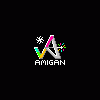
WinArcadia 21.4 (Windows): 26 August 2013
AmiArcadia 21.4 (AmigaOS 3): 26 August 2013
AmiArcadia 21.4 (MorphOS): 26 August 2013
AmiArcadia 21.3 (AmigaOS 4): 1 August 2013
Super Bug Advance 1.3 (GBA): 11 September 2009
AmiArcadia and WinArcadia are multi-emulators of these machines:
* Emerson Arcadia 2001 console family (Bandai, Emerson, Grandstand,
Intervision, Leisure-Vision, Leonardo, MPT-03, Ormatu, Palladium, Poppy,
Robdajet, Tele-Fever, Tempest, Tryom, Tunix, etc.) (1982);
* Interton VC 4000 console family (Acetronic, Fountain, Interton,
Prinztronic, Radofin, Rowtron, Voltmace, Waddington, etc.) (c. 1978);
* Elektor TV Games Computer (1979);
* PIPBUG-based machines (Electronics Australia 77up2 and 78up5, Signetics
Adaptable Board Computer, Eurocard 2650, etc.) (c. 1977-1978);
* Signetics Instructor 50 trainer (1978);
* Central Data 2650 computer (1977);
* Astro Wars, Cat and Mouse, Galaxia, and Laser Battle coin-ops by
Zaccaria (1979-1982);
* Malzak 1 and 2 coin-ops by Kitronix (c. 1980);
* Chaos 2 computer (1983);
* Dolphin trainer (1977);
* PHUNSY computer (c. 1980);
* AY-3-8550/8600-based Pong systems (c. 1976-1977); and
* Ravensburger Selbstbaucomputer aka 2650 Minimal Computer trainer (1984).
Features include: ReAction GUI, load/save snapshots, windowed and full-
screen modes, CPU tracing, trainer, drag and drop support, graphics
scaling, automatic load/save of configuration/game, keyboard/joystick/
gamepad/paddle/mouse/trackball support, autofire, turbo mode, gameplay
recording/playback, PAL/NTSC modes, sprite demultiplexing, help windows,
source code, debugger, frame skipping, redefinable keys, save screenshots
(4 supported formats), ARexx port, network play, real-time monitor, locale
support, game selection sidebar, text-to-speech, printer output,
undithering, support for ZIPped games, clipboard support, palette editor,
tone retuning, high score management, force feedback, sprite editor, 3D,
assembler.
The supported languages are currently English, Dutch, French, German,
Greek, Italian, Russian and Spanish.
Changes since V21.3:
* 2650: debugger CLI: added "ASM" (assemble) command.
* Elektor: "Settings|Graphics|Fill intersections?" option.
* Miscellaneous improvements and bug fixes.
http://amigan.1emu.net/releases/
http://amigan.yatho.com/
MoarNES 0.13.8.21 Alpha released
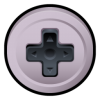
Description:
MoarNES is an emulator for the classic Nintendo Entertainment System video game console. It is relatively new, and currently still in alpha. It is being continuously worked on an improved with the goal of being among the best NES emulators available. Is it there yet? Not quite, but it's a very useable and fairly compatible emulator still at this point. It is written from scratch in C, with no code taken from existing NES emulators.
source: http://sourceforge.net/projects/moarnes/
2013-08-23 Recent Releases

jpcsp r3357 - http://www.jpcsp.org/
Emulator2001 - 2013-07-28 - http://www.gstsoftware.co.nz/
DSEVZ200 - 2013-08-21 - http://www.gstsoftware.co.nz/
EmuLoader 7.3 - http://emuloader.mameworld.info/
Common Source Code Project 2013-08-21 - http://homepage3.nifty.com/takeda-toshiya/main.html
cmpro 4.011a - http://mamedev.emulab.it/clrmamepro/
Pantheon 1.386 - http://bgrandovec.hostzi.com/Content/Download.htm
Pasofami 2.13 - http://www.geocities.jp/pasofami77/download.htm
Stella 3.9.1 released

Description:
Stella is a multi-platform Atari 2600 VCS emulator released under the GNU General Public License (GPL). Stella was originally developed for Linux by Bradford W. Mott, and is currently maintained by Stephen Anthony. Since its original release several people have joined the development team to port Stella to other operating systems such as AcornOS, AmigaOS, DOS, FreeBSD, IRIX, Linux, OS/2, MacOS, Unix, and Windows. The development team is working hard to perfect the emulator and we hope you enjoy our effort.
Change log:
source: http://stella.sourceforge.net
download: Stella 3.9.1

